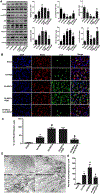Mesenchymal Stem Cells Protect Against Hypoxia-Ischemia Brain Damage by Enhancing Autophagy Through Brain Derived Neurotrophic Factor/Mammalin Target of Rapamycin Signaling Pathway
- PMID: 29451335
- PMCID: PMC6657778
- DOI: 10.1002/stem.2808
Mesenchymal Stem Cells Protect Against Hypoxia-Ischemia Brain Damage by Enhancing Autophagy Through Brain Derived Neurotrophic Factor/Mammalin Target of Rapamycin Signaling Pathway
Abstract
Hypoxic-ischemic encephalopathy (HIE) is a serious disease for neonates. However, present therapeutic strategies are not effective enough for treating HIE. Previous study showed that mesenchymal stem cells (MSCs) can exert neuroprotective effects for brain damage, but its mechanism remains elusive. Using in vitro coculture of rat cortical primary neurons and MSCs in HI conditions, we demonstrated that MSCs help increase brain derived neurotrophic factor (BDNF) and autophagy markers (LC3II and Beclin1) in the cultures and decrease cells death (lactate dehydrogenase levels). We demonstrated a similar mechanism using an in vivo rat model of HI in combination with MSCs transplantation. Using a behavioral study, we further showed that MSCs transplantation into the rat brain after HI injury can attenuate behavioral deficits. Finally, we found that the increase in BDNF and autophagy related factors after HI injury combined with MSCs transplantation can be reversed by anti-BDNF treatment and strengthen the point that the protective effects of BDNF work through inhibition of the mammalin target of rapamycin (mTOR) pathway. Collectively, we proposed that coculture/transplantation of MSCs after HI injury leads to increased BDNF expression and a subsequent reduction in mTOR pathway activation that results in increased autophagy and neuroprotection. This finding gives a hint to explore new strategies for treating neonates with HIE. Stem Cells 2018;36:1109-1121.
Keywords: Autophagy; Brain damage; Brain derived neurotrophic factor; Hypoxia-ischemia; Mammalian target of rapamycin; Mesenchymal stem cells.
© 2018 AlphaMed Press.
Conflict of interest statement
Disclosure of Potential Conflicts of Interest
The authors indicated no potential conflicts of interest.
Figures






Similar articles
-
G-CSF attenuates neuroinflammation and neuronal apoptosis via the mTOR/p70SK6 signaling pathway in neonatal Hypoxia-Ischemia rat model.Brain Res. 2020 Jul 15;1739:146817. doi: 10.1016/j.brainres.2020.146817. Epub 2020 Apr 1. Brain Res. 2020. PMID: 32246916
-
Mesenchymal stem cells-derived IL-6 activates AMPK/mTOR signaling to inhibit the proliferation of reactive astrocytes induced by hypoxic-ischemic brain damage.Exp Neurol. 2019 Jan;311:15-32. doi: 10.1016/j.expneurol.2018.09.006. Epub 2018 Sep 10. Exp Neurol. 2019. PMID: 30213506
-
BDNF-Overexpressing Engineered Mesenchymal Stem Cells Enhances Their Therapeutic Efficacy against Severe Neonatal Hypoxic Ischemic Brain Injury.Int J Mol Sci. 2021 Oct 22;22(21):11395. doi: 10.3390/ijms222111395. Int J Mol Sci. 2021. PMID: 34768827 Free PMC article.
-
Umbilical cord blood mesenchymal stem cells co-modified by TERT and BDNF: a novel neuroprotective therapy for neonatal hypoxic-ischemic brain damage.Int J Dev Neurosci. 2014 Nov;38:147-54. doi: 10.1016/j.ijdevneu.2014.06.014. Epub 2014 Jul 3. Int J Dev Neurosci. 2014. PMID: 24999119 Review.
-
More Insight into BDNF against Neurodegeneration: Anti-Apoptosis, Anti-Oxidation, and Suppression of Autophagy.Int J Mol Sci. 2017 Mar 3;18(3):545. doi: 10.3390/ijms18030545. Int J Mol Sci. 2017. PMID: 28273832 Free PMC article. Review.
Cited by
-
Mesenchymal stem/stromal cell function in modulating cell death.Stem Cell Res Ther. 2019 Feb 13;10(1):56. doi: 10.1186/s13287-019-1158-4. Stem Cell Res Ther. 2019. PMID: 30760307 Free PMC article. Review.
-
Pretreatment of Grape Seed Proanthocyanidin Extract Exerts Neuroprotective Effect in Murine Model of Neonatal Hypoxic-ischemic Brain Injury by Its Antiapoptotic Property.Cell Mol Neurobiol. 2019 Oct;39(7):953-961. doi: 10.1007/s10571-019-00691-7. Epub 2019 May 30. Cell Mol Neurobiol. 2019. PMID: 31147852 Free PMC article.
-
Extracellular Vesicle-Derived microRNA-410 From Mesenchymal Stem Cells Protects Against Neonatal Hypoxia-Ischemia Brain Damage Through an HDAC1-Dependent EGR2/Bcl2 Axis.Front Cell Dev Biol. 2021 Jan 11;8:579236. doi: 10.3389/fcell.2020.579236. eCollection 2020. Front Cell Dev Biol. 2021. PMID: 33505958 Free PMC article.
-
The neuroprotective effect of mesenchymal stem cells is mediated through inhibition of apoptosis in hypoxic ischemic injury.World J Pediatr. 2020 Apr;16(2):193-200. doi: 10.1007/s12519-019-00310-x. Epub 2019 Sep 18. World J Pediatr. 2020. PMID: 31535281
-
A preview of selected articles.Stem Cells Transl Med. 2021 Mar;10(3):333-336. doi: 10.1002/sctm.21-0036. Stem Cells Transl Med. 2021. PMID: 33619898 Free PMC article. No abstract available.
References
-
- Vannucci SJ, Hagberg H. Hypoxia-ischemia in the immature brain. J Exp Biol 2004; 207:3149–3154. - PubMed
-
- Douglas-Escobar M, Weiss MD. Hypoxic-ischemic encephalopathy: A review for the clinician. JAMA Pediatr 2015;169:397–403. - PubMed
-
- Carloni S, Albertini MC, Galluzzi L et al. Increased autophagy reduces endoplasmic reticulum stress after neonatal hypoxia-ischemia: Role of protein synthesis and autophagic pathways. Exp Neurol 2014;255:103–112. - PubMed
Publication types
MeSH terms
Substances
Grants and funding
LinkOut - more resources
Full Text Sources
Other Literature Sources
Miscellaneous

